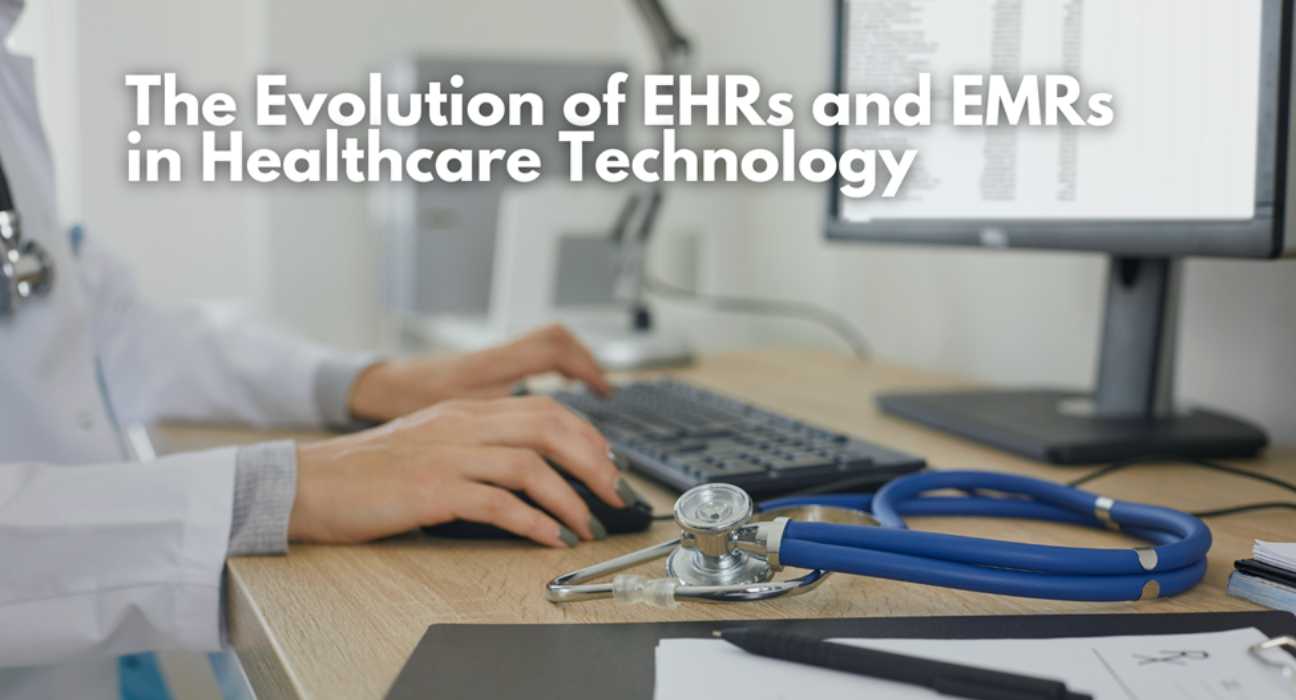The evolution of EHRs and EMRs in healthcare mirrors the journey of technology itself becoming smarter, faster, and more integrated with each step. As healthcare systems face increasing demands for efficiency, accuracy, and patient care improvement, the shift from paper-based records to digital solutions has been pivotal. Electronic Health Records (EHRs) and Electronic Medical Records (EMRs) play a central role in transforming the way medical data is stored, shared, and analyzed.
However, the evolution of electronic health or electronic medical records goes far beyond just the replacement of paper; it is the leverage of innovative, integrated technologies to improve healthcare outcomes.
The Beginnings of EHRs and EMRs
Before the use of digital records in the healthcare industry, patients had paper files held by physicians and caregivers. Industry statistics show that the average person spends 18 minutes searching for information in a paper document. The paper-based systems often resulted in inefficiencies due to lost records, bad handwriting, and difficulties in conveying information between professionals. This led to disintegrated healthcare data and access issues, making it difficult to provide coordinated and efficient care.
The early days of EHR and EMR technology focused more on developing electronic versions of paper records. It was in the 1960s when pioneers realized the potential of using technology to improve patient data management, giving birth to the concept of Electronic Medical Records. However, the technology wasn’t developed well at that time, so it was only until the late 1990s and early 2000s that EMRs were widely adopted. As time went on, the difference between EHRs and EMRs marked a significant turning point in the evolution of healthcare records. EMRs are digital records in healthcare used within a single facility, focusing on improving efficiency and productivity in that specific setting. In contrast, EHRs are designed to be shared across multiple healthcare providers and facilities.
This difference has profound implications for patient care, as EHRs allow healthcare professionals to access up-to-date and complete patient information from different sources, leading to better collaboration, continuity of care, and improved health outcomes.
Technological Advancements and Features
By 2021, almost 4 in 5 office-based physicians (78%) and nearly all non-federal acute care hospitals (96%) had adopted a certified EHR. This reflects significant progress over a decade, up from just 28% of hospitals and 34% of physicians using EHRs in 2011. As the healthcare industry embraced digital technology, both EHR and EMR systems began evolving to incorporate new features and innovations.
Cloud-Based Solutions and Interoperability
One of the most impressive trends in healthcare technology EHR has been the transition from a site-based system toward cloud-based software. Cloud computing provides companies with the capability to keep vast amounts of information confidential while professionals, irrespective of the location, gain easy access to them. With cloud-based systems, providers can access patient records, update medical histories, and collaborate with other professionals in real-time.
Another important advancement is interoperability which is the ability of various systems to communicate and share information. Generally, the earlier EHR and EMR systems maintained operation in isolation, so healthcare providers used to have a difficult time getting access to patient information from a different organization. Today, most EHRs are interoperable, allowing seamless data transfer across different healthcare systems.
Data Security and Privacy
An increase in the digitization of healthcare data has raised concerns about issues of data security and patient confidentiality. Health care is practiced under strict regulations. For example, the Health Insurance Portability and Accountability Act (HIPAA) ensures the confidentiality and security of patient information. Modern EHR and EMR systems have advanced security features like encryption of data, multi-factor authentication, and tough data access controls to protect sensitive information.
Moreover, providers should proactively prevent data breaches by ensuring that the EHR system is consistently upgraded and adheres to the latest security protocols. The need for data privacy safeguards has been a critical factor in the acceptance of digital health records by a large population.
Artificial Intelligence and Machine Learning
Recently, artificial intelligence (AI) and machine learning (ML) have been integrated into the EHR systems to provide diverse analysis of data and insights. AI-powered algorithms can identify patterns in medical histories that may be overlooked by human clinicians. This can result in more accurate diagnosis or even detect potential health risks early.
AI in EHR systems is also being used for predictive analytics, where patient data is analyzed to predict potential future health outcomes. In this respect, AI may predict a risk that a patient may develop chronic conditions like diabetes or heart disease, allowing healthcare providers to intervene early before the condition results in serious health complications.
The Role of EHRs/EMRs in Reducing Healthcare Costs
One of the key benefits that have been accorded to the implementation of EHR and EMR systems is the potential for enormous cost-cutting in the healthcare industry. Healthcare providers are freed from administrative burdens, benefit from streamlined workflows, and experience reduced error impacts when transitioning to electronic records.
Reduction of Administrative Costs
The administrative costs of paper-based systems can be substantial. Healthcare organizations spend so much time and money in handling paper records, from printing and storing files to retrieving information for audits and billing. EHRs and EMRs have even cut down on such costs by automating most administrative tasks, including data entry, patient scheduling, and billing.
Improved Efficiency and Reduced Errors
Several studies have been revealing that the adoption of EHRs has improved efficiency in healthcare delivery. A systematic review and meta-analysis published in the European Journal of Public Health found that EHR use is associated with a 22.4% reduction in documentation time. Likewise, the study found that the use of EHR is associated with a 46% reduction in medication errors. This provides better outcomes for patients and saves more money on healthcare as there would be fewer complications and adverse events.
The Integration of EHRs/EMRs with Other Healthcare Technologies
EHRs and EMRs are no longer separate entities; they have evolved to be part of a more complex network of healthcare technologies meant to optimize patient care and operational efficiency.
Telemedicine Integration
As more people begin to resort to telemedicine for medical services, EHRs are integrated into the telehealth platform. Through an EHR, it has become possible for healthcare providers to use patient history during a virtual visit so that doctors can have all the information at their fingertips. Thus, with this integration, healthcare will be consistent from in-person to remote.
Mobile Health and Patient Portals
Mobile health (mHealth) applications and patient portals enable patients to access their health information via a smartphone or a computer. The utilization of such resources gives patients control over their health information and an opportunity to become more actively involved in their care. Through secure portals, patients may directly place appointments, request refills for prescriptions, or send direct messages to the provider, thereby improving the experience for the patient as well as the health outcomes.
Conclusion
The evolution of EHR and EMR in healthcare has transformed the way medical records are managed and shared. From early digital systems to the more complex, AI-driven systems of today, they have produced improved quality of care, efficiency gains, and lower healthcare costs. As we look toward the future, the continued evolution of EHRs and EMRs promises even greater benefits for patients, healthcare providers, and the industry as a whole.
FAQs
How do EHRs and EMRs improve care coordination between various service providers?
EHR facilitates information sharing among various healthcare providers. A patient’s files are accessed in real-time. This reduces error levels and averts several other adverse outcomes for the patient.
What has been the impact of AI integration on the effectiveness of EHRs and EMRs?
The embedded AI in EHRs fosters the patterns that it finds and can calculate health risks for advanced warning. It helps in clinical decision-making and increases diagnostic validity and early interventions, therefore maximizing patient care.
What are some of the common problems that healthcare providers experience during the implementation of EHR and EMR?
Healthcare providers face huge upfront costs and difficult system integrations. Additionally, issues like staff training or maintaining data security remain significant challenges.

